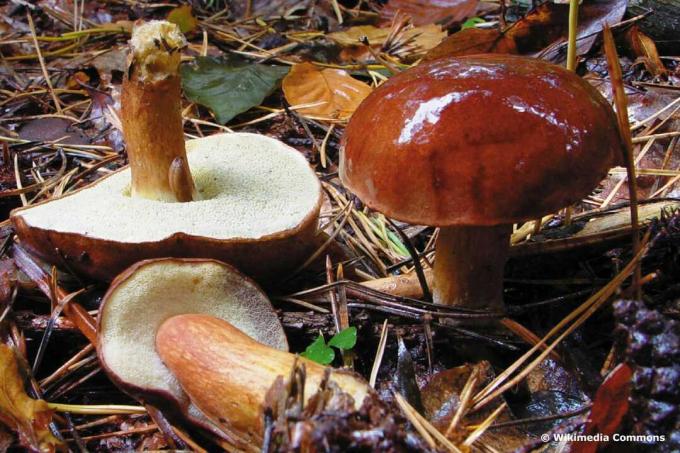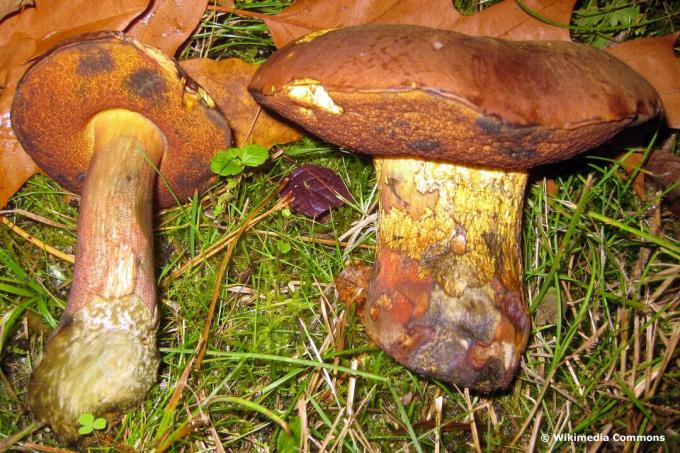
The chestnut is one of the most popular local forest mushrooms. It convinces with firm flesh, a pleasant smell and an excellent taste. Can you confuse chestnut mushrooms with poisonous doubles?
In a nutshell
- widespread in coniferous forests in autumn
- excellent edible mushroom
- good for drying
- raw poisonous
- hardly any risk of confusion with poisonous doubles
Table of contents
- Identify chestnut mushrooms
- Is there a risk of confusion?
- Toxic doubles
- Non-Toxic Doubles
- frequently asked Questions
Identify chestnut mushrooms
Chestnut boletus (Imleria badia) can be found in coniferous forests as early as the end of June. The main collection time however, is in the fall. If you use the following characteristics as a guide, you minimize the risk of confusing chestnut mushrooms with poisonous doubles:

| cap | stalk | Meat |
|---|---|---|
| 5 to 15 centimeters in diameter young hemispherical, later flatly convex chocolate to maroon velvety surface Tubes pale yellow, later olive yellow |
8 to 12 inches long about 2 centimeters thick full never with mesh drawing |
white to pale yellow faintly blue firm and tender when young, later softer smell very pleasant Taste extremely good |
Danger: Chestnut boletes are poisonous when raw!
Is there a risk of confusion?
The chestnut boletus can be eaten with some other Boletus be confused. There is only a danger if you confuse chestnut mushrooms with the poisonous gall boletus. Be sure to follow our instructions!
Toxic doubles
Gall boletus (Tylopilus felleus)
The only inedible double of the chestnut bolete is the bile bolete. You can recognize him by a minimal taste. The meat tastes bitter.

| Happen | characteristics | Value |
|---|---|---|
| sparse coniferous forests, deciduous forests, near spruce | red-brown cap surface Tubes first white, later pink to grey-pink |
inedible |
Non-Toxic Doubles
Porcini mushroom (Boletus edulis)
The mushroom is probably the best known and most popular native mushroom at all. It is not without reason that it is also referred to as the master mushroom or noble mushroom.

| Happen | characteristics | Value |
|---|---|---|
| Deciduous and coniferous forests, prefers sandy soil | smooth dark brown hat very fine white pores white stem with a fine mesh pattern |
excellent edible mushroom |
A notice: In contrast to chestnuts, porcini mushrooms do not turn blue when pressure is applied.
Flake-stemmed witch bolete (Neoboletus erythropus)
Chestnut boletes look like this at first glance Flake-stemmed witch boletus similar. Don't worry, despite the dangerous-sounding name, this one is also edible. The red tubes make it easy to tell them apart.

| Happen | characteristics | Value |
|---|---|---|
| mixed forest acidic soils |
velvety red-brown hat dark red tubes yellow stem without mesh pattern |
tasty, mild |
A notice: It used to be believed that the blue coloring of some mushroom species had something to do with witchcraft. This is how the witch bolete got its name.
frequently asked Questions
Chestnut boletes impress with their nutty taste. They can be fried or braised. An insider tip is seasoning powder made from chestnuts. To do this, the mushrooms are dried and finely ground. You can mix the powder with dried herbs.
Chestnuts are unfortunately often maggots. For this reason, the mushrooms must be cleaned carefully. First scrape the dirt off the cap with a knife. Cut off the stem end. Remove wormy or slug-eaten parts. Detach the tubes from the stem.
As mycorrhizal fungi, chestnuts mainly live in symbiosis with various conifers. With its fine network of fungi, the fungus establishes a connection to the tree. This supplies the fungus with glucose, which is produced during photosynthesis. In return, the mycorrhizal fungus releases phosphorus and nitrogen to the tree. Tree and fungus benefit from this connection.
